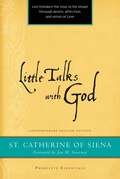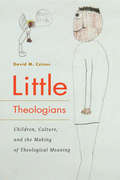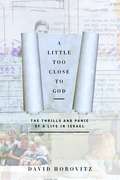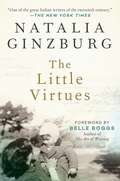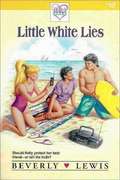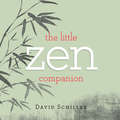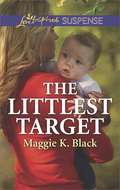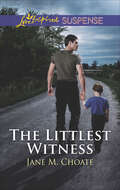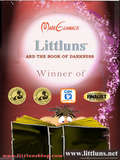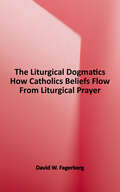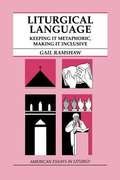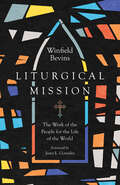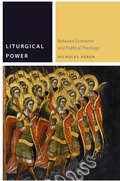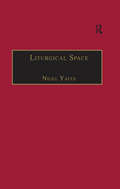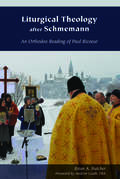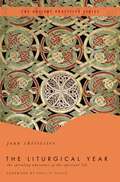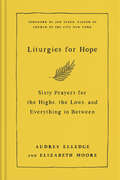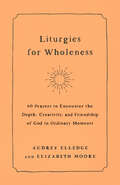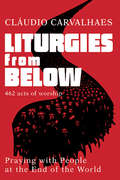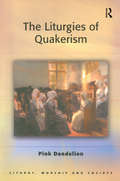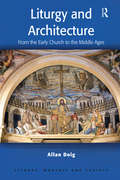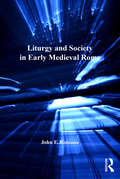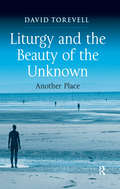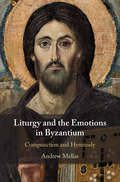- Table View
- List View
Little Talks with God (Paraclete Essentials)
by Catherine of Catherine of Siena"Eternal greatness! You made yourself low and small to make mankind great." While in an ecstatic trance, St. Catherine of Siena dictated The Dialogue. In this intense and searching work, she offers up petitions to God, filling her conversation with instruction on discernment, true and false spiritual emotion, obedience and truth, and revealing her famous image of Christ as the Bridge. Catherine's brilliant insights into the nature of the spiritual life have motivated Christians for centuries to unite a life of prayer with a life of action. "This have I told you, my sweetest daughter, that you might know the perfection of this union-producing state, when the eye of the intellect is ravished by the fire of my charity, in which it receives supernatural light. With this light the souls in the state of union love me, because love follows the intellect, and the more it knows the more it can love." (from the book)
Little Theologians: Children, Culture, and the Making of Theological Meaning
by David M. CsinosChildren don't just learn theology. They actively create it, playing with ideas and drawing together aspects of their own lives to form theological understanding. David Csinos offers a groundbreaking exploration of how cultural contexts intersect with the theological meaning-making of children.
A Little Too Close To God: The Thrills and Panic of a Life in Israel
by David HorovitzJournalist David Horovitz describes his life in Israel since his emigration from England in 1983. Throughout the text, he struggles with the conflict between the dangers and benefits of raising his family in Israel. He describes the effects of Rabin's assassination, the incursions of the ultra-Orthodox into daily life, the anxieties of parents as their children approach the age of mandatory military service, and the constant fear of violent attack by fundamentalist extremists. Annotation c. Book News, Inc. , Portland, OR (booknews. com)
The Little Virtues: Essays
by Natalia Ginzburg Belle BoggsIn this collection of her finest and best-known short essays, Natalia Ginzburg explores both the mundane details and inescapable catastrophes of personal life with the grace and wit that have assured her rightful place in the pantheon of classic mid-century authors. Whether she writes of the loss of a friend, Cesare Pavese; or what is inexpugnable of World War II; or the Abruzzi, where she and her first husband lived in forced residence under Fascist rule; or the importance of silence in our society; or her vocation as a writer; or even a pair of worn-out shoes, Ginzburg brings to her reflections the wisdom of a survivor and the spare, wry, and poetically resonant style her readers have come to recognize. "A glowing light of modern Italian literature . . . Ginzburg's magic is the utter simplicity of her prose, suddenly illuminated by one word that makes a lightning streak of a plain phrase. . . . As direct and clean as if it were carved in stone, it yet speaks thoughts of the heart.' — The New York Times Book Review
Little White Lies (Holly's Heart #10)
by Beverly LewisBook 10 of HOLLY'S HEART. Holly and Andie are headed to California, when Andie falls for an older boy. Holly wants to tell someone, but stretching the truth causes major problems and soon they're in a situation only God can make right.
The Little Zen Companion
by David SchillerWhile it seeks neither to define Zen nor answer its most famous koan (a riddle unanswerable by conventional thinking, in this case the sound of one hand clapping), this bestselling little book with 437,000 copies in print possesses a maverick Zen spirit that points to a different way of looking at the world.With each page featuring a quote, phrase, story, koan, haiku, or poem, Zen Companion combines the feeling and format of a meditation book with 2,500 years of wisdom-from Lao-tzu and Groucho Marx, William Carlos Williams and The Little Prince, D. T. Suzuki and Walker Percy, the Buddha and the Bible, Einstein and Gertrude Stein. It's a celebration of intuition: "If a man wishes to be sure of the road he treads on, he must close his eyes and walk in the dark"-St. John the Cross. Individuality: "Do not seek to follow in the footsteps of the men of old; seek what they sought."-Basho. Uncomplicated nature: "Among twenty snowy mountains/The only moving thing/Was the eye of the blackbird."-Wallace Stevens. Childlike spontaneity: "Goodnight stars. Goodnight air."-Margaret Wise Brown. Irreverent paradox: "Wakuan complained when he saw a picture of bearded Bodhidharma: 'Why hasn't that fellow a beard?'" And above all, the simple pleasure of life lived in the moment. "Chop wood, carry water."
The Littlest Angel
by Charles TazewellHe is always late! He's been caught swinging on the golden gates! He chews on his wings! He sings off key! And, then... something happens... A wonderful book for children and grandparents to read together.
The Littlest Target: Guarding The Babies The Littlest Target Fugitive Spy (True North Heroes)
by Maggie K. BlackNanny and baby on the runA taut thriller in the True North Heroes seriesWhen her boss’s wife is murdered before her eyes, nanny Daisy Hayward flees with her infant charge. But she can’t escape danger. Someone wants the baby and will kill Daisy to get him. In the Canadian wilderness, a paramedic saves them. But when Daisy is framed for murder and labeled a kidnapper, will Max Henry help her...or turn her in?
The Littlest Witness
by Jane M. ChoateA soldier and a Secret Service agent join forces to protect an orphan from his parents’ killers in this inspirational romantic suspense tale.When Delta Force soldier Caleb Judd’s brother and sister-in-law are murdered, the killers turn their attention on his orphaned nephew. Caleb’s new mission: protect little Tommy—who hasn’t said a word since witnessing his parents’ deaths—and figure out who’s targeting his family. He needs help, and security expert Shelley Rabb is perfect for the job. But Caleb’s used to calling the shots, not taking orders . . . even when they come from a beautiful former Secret Service agent. Shelley knows firsthand what can happen when business becomes personal, so she vows not to get too close to Caleb and his nephew. She will risk her life to make sure they’re safe, but will that mean risking her heart, too?Praise for The Littlest Witness“Choate’s latest is full of palpable emotions and dangerous twists. The characters demonstrate that life is rarely smooth and easy, but is instead full of numerous turns—just like the book.” —RT Book Reviews
Littluns and the Book of Darkness
by Mark GlamackFor All Seasons and All Reasons. Littluns are mythical little people (little one's) only about three-feet in height, but more importantly representative of God's perfect creation; what He intended for us all on Earth as it is in Heaven. Their secret homeland is paradise found (and kept) with peace and prosperity the norm and not the exception. On what should be a pleasant Scavenger Hunt outing, five "Littluns" journey down from their secret mountaintop homeland, only to find themselves trapped within the darkness that is consuming the land below, spreading terror, destruction and extermination in its path. Five Littluns sacrifice everything in this most crucial journey and adventure of a lifetime. After the sky had fallen onto the land below, and eventually Satan being incarcerated to a bottomless pit, the world enjoyed peace for a thousand years. Soon afterward the beast was released once again. To now complete his purpose while entering the realm of the living, along with the necessity of possessing the body of a human host, it becomes necessary for the Evil One to place most of his more dark powers into his newly created Book of Darkness because no living-being could possess those evil words and survive. But through a twist of fate, his book becomes lost and now to fulfill his mission he must have his book back at all costs. A multi-award winning family friendly book including two "Mom's Choice" awards, Littluns: And the Book of Darkness" is perfect for readers of all ages looking for a very different reading experience. It's a one-of-a-kind adventure depicting true friendships; full of valued choices between right and wrong, good or evil, God's light in contrast to Satan's darkness. For the "Young Adult" and grown-up Christian and secular reader, Littluns are an ageless example of courage under the worst possible conditions and what it means to love and be loved under God.
Liturgical Dogmatics: How Catholic Beliefs Flow from Liturgical Prayer
by David W. FagerbergGod is indescribable: "not-able-to-be-written-down". How can we do dogmatics when there is an absolute difference between the Creator and the creature? How dare we say anything about God without his permission? God is incomprehensible, but he is not unapproachable. He gives access to himself in the liturgy he has given us. There, what dogma stammers to state, liturgy celebrates in mystical participation; what knowledge cannot fasten together, love unites. Liturgical Dogmatics examines dogma in light of liturgy. It is not a theology of liturgy, because it does not look at liturgy; rather, it looks through liturgy to see the whole sweeping saving activity of God, which dogma describes. Through this lens, the author illuminates thirty-six classic dogmas in a readable and sometimes imaginative way. He shows that while dogma protects the mystery of divine love from heretical corruption, its final goal is achieved when the believer is united to that mystery in liturgical worship.
Liturgical Language: Keeping It Metaphoric, Making It Inclusive
by Gail RamshawThrough a review of the history of language, Ramshaw illustrates the difficulties of forming texts from words that have undergone numerous translations and whose primary meanings have also changed throughout the centuries. Her discussion of symbolic imagery and theological language illustrates how essential it is that words be evaluated and chosen with understanding and care.
Liturgical Mission: The Work of the People for the Life of the World
by Winfield BevinsModern missional movements have often viewed the historic Christian traditions with suspicion.Liturgical Mission
Liturgical Power: Between Economic and Political Theology (Commonalities)
by Nicholas HeronIs Christianity exclusively a religious phenomenon, which must separate itself from all things political, or do its concepts actually underpin secular politics? To this question, which animated the twentieth-century debate on political theology, Liturgical Power advances a third alternative. Christian anti-politics, Heron contends, entails its own distinct conception of politics. Yet this politics, he argues, assumes the form of what today we call “administration,” but which the ancients termed “economics.” The book’s principal aim is thus genealogical: it seeks to understand our current conception of government in light of an important but rarely acknowledged transformation in the idea of politics brought about by Christianity.This transformation in the idea of politics precipitates in turn a concurrent shift in the organization of power; an organization whose determining principle, Heron contends, is liturgy—understood in the broad sense as “public service.” Whereas until now only liturgy’s acclamatory dimension has made the concept available for political theory, Heron positions it more broadly as a technique of governance. What Christianity has bequeathed to political thought and forms, he argues, is thus a paradoxical technology of power that is grounded uniquely in service.
Liturgical Space: Christian Worship and Church Buildings in Western Europe 1500-2000 (Liturgy, Worship and Society Series)
by Nigel YatesThis is the first comprehensive and up-to-date account of the internal arrangement of church buildings in Western Europe between 1500 and 2000, showing how these arrangements have met the liturgical needs of their respective denominations, Catholic and Protestant, over this period. In addition to a chapter looking at the general impact of the Reformation on church buildings, there are separate chapters on the churches of the Lutheran, Reformed, Anglican and Roman Catholic traditions between the mid-sixteenth and mid-nineteenth centuries, and on the ecclesiological movement of the nineteenth century and the liturgical movement of the twentieth century, both of which have impacted on all the churches of Western Europe over the past 150 years. The book is extensively illustrated with figures in the text and a series of plates and also contains comprehensive guides to both further reading and buildings to visit throughout Western Europe.
Liturgical Theology after Schmemann: An Orthodox Reading of Paul Ricoeur (Orthodox Christianity and Contemporary Thought)
by Brian A. ButcherWhile only rarely reflecting explicitly on liturgy, French philosopher Paul Ricoeur (1913-2005) gave sustained attention to several themes pertinent to the interpretation of worship, including metaphor, narrative, subjectivity, and memory. Inspired by his well-known aphorism, “The symbol gives rise to thought,” Liturgical Theology after Schmemann offers an original exploration of the symbolic world of the Byzantine Rite , culminating in a Ricoeurian analysis of its Theophany “Great Blessing of Water.” . The book examines two fundamental questions: 1) what are the implications of the philosopher’s oeuvre for liturgical theology at large? And 2)how does the adoption of a Ricoeurian hermeneutic shape the study of a particular rite? Taking the seminal legacy of Orthodox theologian Alexander Schmemann (1921-1983) as its point of departure, Butcher contributes to the renewal of contemporary Eastern Christian thought and ritual practice by engaging a spectrum of current theological and philosophical conversations.
The Liturgical Year: The Spiraling Adventure of the Spiritual Life - The Ancient Practices Series
by Joan ChittisterA journey of the soul through the map of Christian time.The liturgical year, beginning on the first Sunday of Advent and carrying through the following November is the year that sets out to attune the life of the Christian to the life of Jesus, the Christ. This book sets out to open what may at first seem to be simply an arbitrary arrangement of ancient holy days or liturgical seasons to their essential relationship to one another and their ongoing meaning to us today. It is an excursion into life from the Christian perspective, from the viewpoint of those who set out not only to follow Jesus but to live as Jesus lived and to think as Jesus thought.It proposes, year after year, to immerse us over and over again into the sense and substance of the Christian life until, eventually, we become what we say we are-followers of Jesus all the way to the heart of God. It is an adventure in human growth; it is an exercise in spiritual ripening.
Liturgies for Hope: Sixty Prayers for the Highs, the Lows, and Everything in Between
by Audrey Elledge Elizabeth MooreSixty contemporary, comforting liturgies that break through the noise of modern life to offer time-tested wisdom for readers navigating burnout, anxiety, and other stresses.&“Beautiful words to help us access the longings of our souls and bring them to God. If you&’re looking for a jumpstart to your spiritual life, start here.&”—Rich Villodas, lead pastor of New Life Fellowship and author of Good and Beautiful and KindRemind us, Jesus, that You lay sleeping in the boat, in the middle of the storm at sea. You are neither surprised nor distressed by the mounting chaos. You are not a God who panics.When writers Audrey Elledge and Elizabeth Moore were inspired to create an anchor of hope for their own local community, they moved forward by turning to the past, to a time when Christians looked at the collapsing world around them and resolved to offer something beautiful—something true—through poetic prayers. The stunning result is Liturgies for Hope, an original collection of modern liturgies reminiscent of past generations of faith. Designed to awaken your prayer life, the entries in this gentle guide explore experiences such as• feeling burned-out and soul-weary• embracing the mystery of faith• receiving the kindness of others• struggling with secret shame• bursting with thanksgivingWith Scripture references for every prayer, Liturgies for Hope is both timeless and ideal for this moment, offering words to express our longings, shore up our prayers, and reorient our souls.
Liturgies for Wholeness: 60 Prayers to Encounter the Depth, Creativity, and Friendship of God in Ordinary Moments
by Audrey Elledge Elizabeth MooreSixty modern and inspiring liturgies that offer compassionate insight to nurture your soul, from the bestselling authors of Liturgies for Hope.&“A voice of reassurance and a much needed reminder of the hope we have.&”—Joshua Luke Smith, performing artist, pastor, and authorWhat if my current life is preparing me for something I can&’t see? Oh God, when I feel overlooked and forgotten,when I ache to be important,redirect my heart to You who remembers me. When your spirit is restless and you can&’t find the words, these modern-day liturgies help you articulate your brokenness to the God who calls you beloved.The lyrical prayers in Liturgies for Wholeness name our longings—the ache for physical rest, the grief over something we never had, the desire for healing in a relationship—even as they call us to notice the blessing of washing our face and watching nightfall and sink deep into an awareness of God&’s presence.Divided into eight sections—including Mind, Senses, Body, Home, and Community—these liturgies can be read communally or individually to bring you into greater intimacy with God. Each prayer includes related Scripture references to offer you further opportunity for meditation and reflection.With each liturgy in Liturgies for Wholeness, may you sense God&’s deep desire for you and may you delight in the only One who can make you whole.
Liturgies from Below - UK Edition: Praying with People at the Ends of the World
by Claudio CarvalhaesIt’s been said that prayer is the vocabulary of faith. This book offers a wealth of resources from forgotten places to help us create a new vocabulary for worship and prayer, one that is located amidst the poor and the major issues of violence and destruction around the world today. It is a collection of prayers, songs, rituals, rites of healing, Eucharistic and baptismal prayers, meditations and art from four continents: Asia-Pacific Islands, Africa, Americas, and Europe. Liturgies from Below is the culmination of a project organized by the Council for World Mission (CWM) during 2018-2019. Approximately 100 people from four continents worked with CWM, collaborating to create indigenous prayers and liturgies expressing their own contexts, for sharing with their communities and the rest of the world. The project was called "Re-Imagining Worship as Acts of Defiance and Alternatives in the Context of Empire". The author and others spent weeks living in each of four communities for several weeks/months, getting to know the people, and then facilitating the people’s own creation of prayers and liturgies. The author, other scholars, pastors, artists, activists and students all came from radically different ethnicities, races, sexualities, churches and Christian theologies. The people in each location were poor, living in very challenging communities, living in oppressive and seemingly hopeless situations. After some time, they wrote prayers and stories of their experience trying to live the Christian faith in utterly abandoned places. What we have here is an immensely rich and varied collection of liturgical sources from various communities dealing with issues of violence, immigration/refugees, drugs, land grabbing, war on the poor, attack on women, militarization, climate change, and so on.
The Liturgies of Quakerism (Liturgy, Worship and Society Series)
by Pink DandelionThe Liturgies of Quakerism explores the nature of liturgy within a form of worship based in silence. Tracing the original seventeenth century Quakers' understanding of the 'liturgy of silence', and what for them replaced the outward forms used in other parts of Christianity, this book explains how early Quaker understandings of 'time', 'history', and 'apocalyptic' led to an inward liturgical form. The practices and understanding of twenty-first century Liberal Quakers are explored, showing that these contemporary Quakers maintain the same kind of liturgical form as their ancestors and yet understand it in a very different way. Breaking new ground in the study of Quaker liturgy, this book contrasts the two periods and looks at some of the consequences for the study of liturgy in general, and Quakerism in particular. It also explores evangelical Quaker understandings of liturgy.
Liturgy and Architecture: From the Early Church to the Middle Ages (Liturgy, Worship and Society Series)
by Allan DoigIn this book Allan Doig explores the interrelationship of liturgy and architecture from the Early Church to the close of the Middle Ages, taking into account social, economic, technical, theological and artistic factors. These are crucial to a proper understanding of ecclesiastical architecture of all periods, and together their study illuminates the study of liturgy. Buildings and their archaeology are standing indices of human activity, and the whole matrix of meaning they present is highly revealing of the larger meaning of ritual performance within, and movement through, their space. The excavation of the mid-third-century church at Dura Europos in the Syrian desert, the grandeur of Constantine's Imperial basilicas, the influence of the great pilgrimage sites, and the marvels of soaring Gothic cathedrals, all come alive in a new way when the space is animated by the liturgy for which they were built. Reviewing the most recent research in the area, and moving the debate forward, this study will be useful to liturgists, clergy, theologians, art and architectural historians, and those interested in the conservation of ecclesiastical structures built for the liturgy.
Liturgy and Society in Early Medieval Rome (Church, Faith and Culture in the Medieval West)
by John F. RomanoThe liturgy, the public worship of the Catholic Church, was a crucial factor in forging the society of early medieval Rome. As the Roman Empire dissolved, a new world emerged as Christian bishops stepped into the power vacuum left by the dismantling of the Empire. Among these potentates, none was more important than the bishop of Rome, the pope. The documents, archaeology, and architecture that issued forth from papal Rome in the seventh and eighth centuries preserve a precious glimpse into novel societal patterns. The underexploited liturgical sources in particular enrich and complicate our historical understanding of this period. They show how liturgy was the ’social glue’ that held together the Christian society of early medieval Rome - and excluded those who did not belong to it. This study places the liturgy center stage, filling a gap in research on early medieval Rome and demonstrating the utility of investigating how the liturgy functioned in medieval Europe. It includes a detailed analysis of the papal Mass, the central act of liturgy and the most obvious example of the close interaction of liturgy, social relations and power. The first extant Mass liturgy, the First Roman Ordo, is also given a new presentation in Latin here with an English translation and commentary. Other grand liturgical events such as penitential processions are also examined, as well as more mundane acts of worship. Far from a pious business with limited influence, the liturgy established an exchange between humans and the divine that oriented Roman society to God and fostered the dominance of the clergy.
Liturgy and the Beauty of the Unknown: Another Place
by David TorevellContemporary culture is rediscovering the importance of beauty for both social transformation and personal happiness. Theologians have sought, in their varied ways, to demonstrate how God's beauty is associated with notions of truth and goodness. This book breaks new ground by suggesting that liturgy is the means par excellence by which an experience of beauty is communicated. Drawing from both secular and religious understandings, in particular the mystical and apophatic tradition, the book demonstrates how liturgy has the potential to achieve the one ultimately reliable form of beauty because its embodied components are able to reflect the disturbing beauty of the One to whom worship is always offered. Such components rely on understanding the aesthetic dynamics upon which liturgy relies. This book draws from a broad range of disciplines concerned with understanding beauty and self-transformation and concludes that while secular utopian forms have much to contribute to ethical transformation, they ultimately fail since they lack the Christological and eschatological framework needed, which liturgy alone provides.
Liturgy and the Emotions in Byzantium: Compunction and Hymnody
by Andrew MellasThis book explores the liturgical experience of emotions in Byzantium through the hymns of Romanos the Melodist, Andrew of Crete and Kassia. It reimagines the performance of their hymns during Great Lent and Holy Week in Constantinople. In doing so, it understands compunction as a liturgical emotion, intertwined with paradisal nostalgia, a desire for repentance and a wellspring of tears. For the faithful, liturgical emotions were embodied experiences that were enacted through sacred song and mystagogy. The three hymnographers chosen for this study span a period of nearly four centuries and had an important connection to Constantinople, which forms the topographical and liturgical nexus of the study. Their work also covers three distinct genres of hymnography: kontakion, kanon and sticheron idiomelon. Through these lenses of period, place and genre this study examines the affective performativity hymns and the Byzantine experience of compunction.
